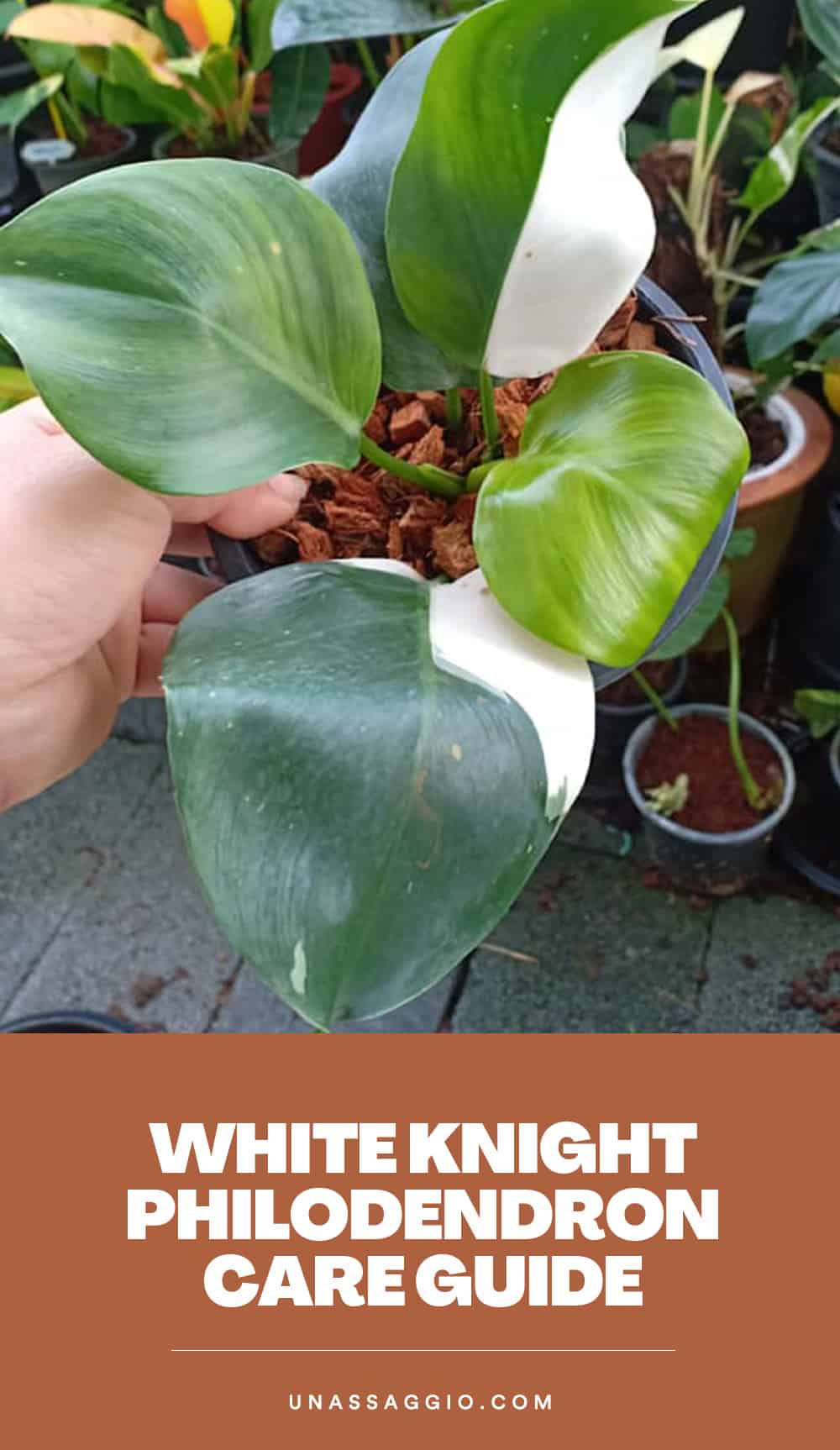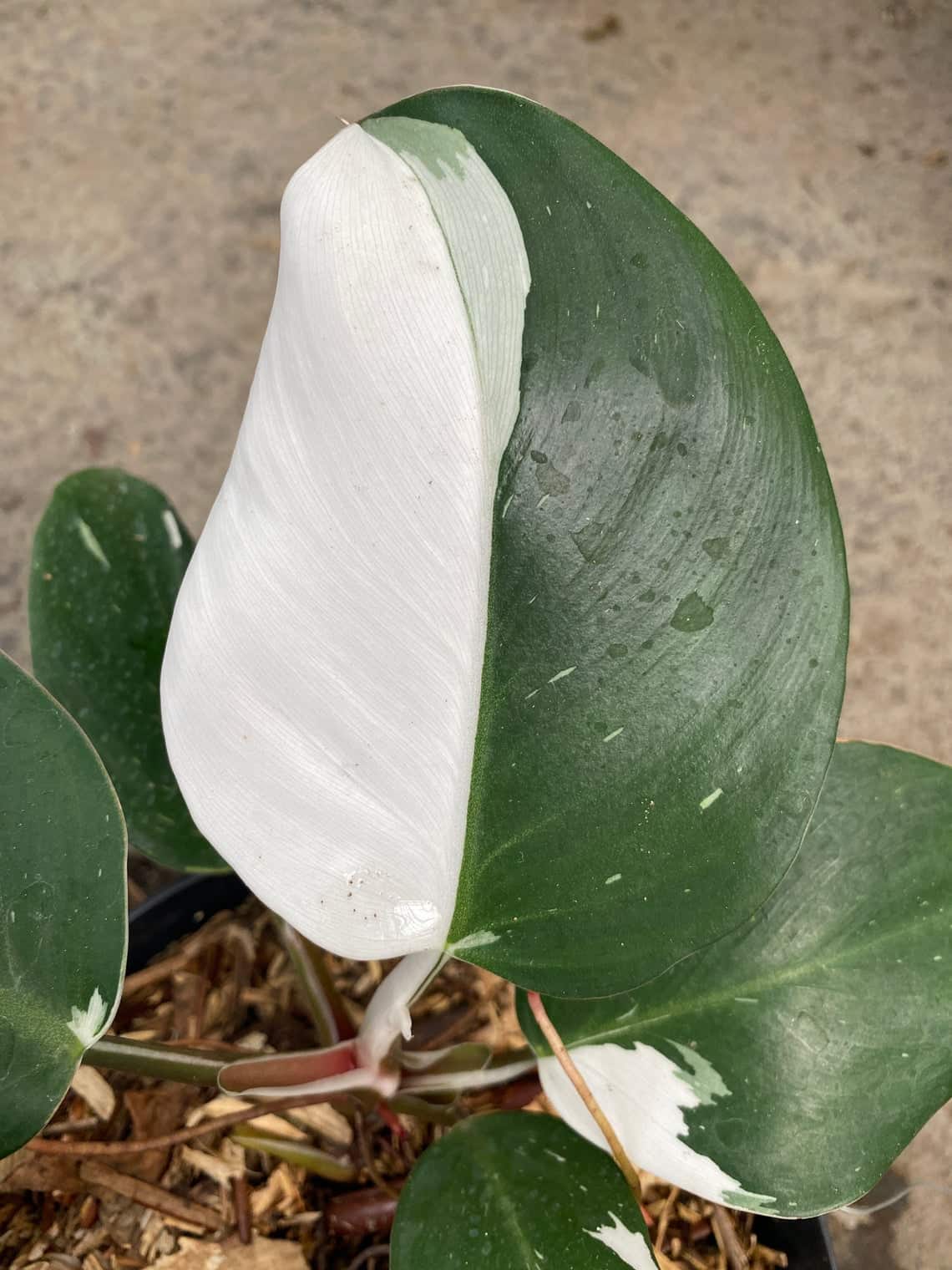Have you ever looked at any houseplant and exclaimed, what a wonder!? If you have, it must have been a white knight philodendron. This plant looks as elegant and sophisticated as it sounds. It is not your regular house plant.
Ever heard the saying every time spent is worth the wait? Every white knight philodendron grower has heard this during the propagation process of this plant because they take longer to grow than most, but in the end, every time spent is truly worth the wait. The very amazing foliage appearance of green, white, purple, and cream that this plant exudes upon bloom is a sight to behold.
This unique plant can be planted indoors, outdoors, and guess what? You could make them grow on poles too. The choice is dependent on whatever tickles your fancy. The White knight philodendron although rare and relatively slow in growth is an easy maintenance plant meaning its sophistication in name and appearance does extend to its care. Cool, isn’t it?
Just in case the white knight philodendron is the next house plant to be added to your garden or to spice up your home, this article is a must-read.
This article provides all you need to know on white knight philodendron; its origin, propagation methods, plant care, frequently asked questions, and even care tips. By the end of this article, you are sure to be identified as a budding white knight philodendron grower.
Table of Contents
White Knight Philodendron Plant Background
| Common Name | White knight |
| Botanical Name | White knight Philodendron |
| Light | Bright indirect light |
| Plant type | Tropical nature |
| Soil type | Organic soil |
| Soil ph. | Well-drained |
| Water | Moderate |
| Temperature | 60°F – 80°F |
| Native | South America |
| Toxicity | Toxic. |
The White Knight Philodendron has trailing features which means that they could be grown on trees, walls, or even poles. Using dangly baskets is a beautiful way of hanging these beauties in your home.

These pricy but exquisite houseplants which are native to South America belong to the Araceae family. The White Knight Philodendron is characterized by the splotches of green and white; there are times the leaf is divided into separate halves of green and white. These plants can grow up to 10 ft. in height. The color combination of this plant is what holds our attention.
White Knight Philodendron Propagation Methods
As earlier mentioned, propagating the white knight is not as sophisticated as the name implies neither is it difficult. The only issue with this houseplant is that its growth rate is slower than other house plants. Here are different ways you could propagate your White Knight Philodendron.
White Knight Philodendron Propagation via water
- Use a clean scissor to cut along stems to remove individual leaf cuttings. Ensure that cutting is below the node of the plant.
- The cutting should be placed in a clean jar or container of water.
- In placement, the node of the plant must be below the water.
- Choose a location where the plant can receive bright but indirect light.
- Choose a location with a warm temperature and low humidity.
- Change the water in the container 2-3 times per week.
- After notable root growth has developed, move the plant to a permanent location with organic soil.
White Knight Philodendron via Stem Cutting
- Select drilled container filled with organic soil.
- Water the soil and drain out water through the drilled holes. the soil mix must be moist after watering.
- Cut the part that extends to a node towards the base of the stem; part cut must not be pest-infested or diseased.
- Use a clean stick to make a hole in the pot or container, then stick in the stem into the hole and use the moist soil mixture to hold the plant firmly.
- Place the container where it would receive bright indirect light.
- Ensure the soil never dries out before watering.
- After the root has developed, move the plant to a permanent location.
Most house plant growers tend to be scared during the propagation process of the White Knight Philodendron especially when they discover the plant is not growing at an expected rate. It is important to note that white knight takes a tad longer to grow than other plants so you might need to wear a cloak of patience all through the propagation process.
White knight Philodendron Plant Care
Caring and nurturing a white knight philodendron is very easy so long as you are acquainted with the basic requirements.
1. Light
Any area with bright indirect light is perfect for your White Knight Philodendron. Lighting is very important to the growth of the White Knight Philodendron.

Depriving this plant of sufficient light is making it susceptible to slow growth and even plant damage. If you decide to grow outdoors, ensure the plant is placed in an area where it can receive bright but indirect light from the sun. If indoors, ensure the plant is where it can receive light; a suitable location is near a window. If the placement does not allow enough access to sunlight, artificial light would help.
You could make use of bulbs and fluorescent. Remember to provide shade for the plant if grown outdoors as exposure to direct sunlight would affect the foliage appearance.
2. Humidity
White Knight Philodendrons are tropical plants that thrive in relatively low humid environments. Areas, where the air is dry, are not suitable for this plant. If providing a low humid environment proves to be a hurdle, you could make use of humidifiers or mist the plant leaves regularly.
This increases the humid level of the environment for the plant. In addition, you could grow the plant amidst other plants to increase the humidity level.
3. Temperature
This beautiful plant thrives in areas with low temperatures between 60°F – 80°F. During winter, growers are advised to move the White Knight Philodendron to a warmer temperature. Extreme weather conditions do not do well on White Knight Philodendrons. Too hot or too cold weather conditions.
4. Pruning
This is an essential aspect of the growth process. When White Knight Philodendrons become bushy, it is important to prune them to maintain the beautiful shape of this plant. Pruning helps eliminate dead and affected parts of the plant.
Also, pruning ensures that all parts of the plant receive adequate because once the plant gets bushy, some parts would be deprived of certain nutrients/requirements like light.
5. Potting
In choosing a container for your White Knight Philodendron, ensure the pots have drilled holes that allow for good water drainage. This helps prevent overwatering. Asides from this, potting enhances the beauty of the plant.

6. Watering
This is a core requirement of your plant. Watering determines the growth rate of your plant. If your plant is underwatered for long, the soil would be unable to provide sufficient nutrients for your plant. In reverse, if overwatered, which is a leading problem in the propagation of this plant, the soil would be waterlogged. Waterlogged soil is a major cause of root rot; root rot is the fastest killer of houseplants because the growth would be inhibited.
7. Soil Mixture
White Knight Philodendrons thrive in organic soil. Adding peat moss or perlite improves the organic level of your soil.
While Knight Philodendron FAQs
Is White Knight Philodendron expensive?
Yes, they are expensive. The White Knight is pricier than other houseplants because they are high in demand and low in supply. These plants take longer than most to grow which is the cause for low supply.
How much water does my White Knight Philodendron need?
Your White Knight Philodendron plant requires a moderate amount of water. Check the soil surface for dryness level before watering, this helps gauge how much water the plant needs. In watering, ensure the soil mix remains moist and never soggy.
Does my White Knight love to be misted?
Yes, the White Knight loves to be misted regularly. Misting improves the humidity level of your plant. Remember to mist both sides of the leaf so no part dries out.
How much light does my White Knight Philodendron need?
Your plant needs bright but indirect light. This plant requires about 4-5 hours of bright indirect sunlight daily.
Is White Knight Philodendron toxic?
Yes, the White knight is toxic to both humans and pets. Ingestions could lead to irritation and swelling around the mouth region. It is best to see a doctor or Veterinary doctor immediately after ingestion.
Why does my White Knight Philodendron have brown leaves?
Brown leaves in White Knights occur when the plant is deprived of sufficient lighting. Place plant in a location where it can receive sufficient lighting. Make use of artificial lighting like bulbs in the absence of natural sunlight.
Why does my White Knight Philodendron have yellow leaves?
Yellow leaves usually occur due to overwatering. Overwatering leads to root rot and a sign of root rot is the plant’s color would start changing.
When should I repot my White Knight Philodendron?
You should repot your White knight when it has outgrown its current pot. Delay in repotting would stifle the growth of your plant.
Final note
With all of this information, you are good to go with your White Knight Philodendron propagation. Few tips would further ease your propagation journey; they include:
- Change the location of your White Knight Philodendrons during winter as the weather condition in this season can be very harsh to your plants. You could move the plant indoors or to a greenhouse location.
- Mist the plant regularly to keep the foliage appearance neat and attractive and also to wade off pests.
- Prune regularly to allow even spread of nutrients.
- Use liquid soluble fertilizers to enhance the growth of the plant.
- Do not allow pest infestations to linger as they could destroy the plant.
- When handling these plants, make use of gloves to avoid negative reactions or skin or transmission of toxins from the plant into the body.
Following this care guide is enough to set you on your White Knight Philodendron journey. Be rest assured you are going to have a massive bloom.
Discover more houseplant care guides:
- Philodendron Vs Pothos: The Difference Explained
- Calathea vs Stromanthe: Differences, Similarities Explained
- Calathea Varieties: The Most Beautiful Types Of Calathea Plants For Your Home
- Philodendron Varieties: 16 Types Of Philodendron Plants For Your Home
- Epiphyllum Cactus Plant: The Complete Growth And Care Guide
- Calathea Orbifolia Plant: The Complete Growth And Care Guide







